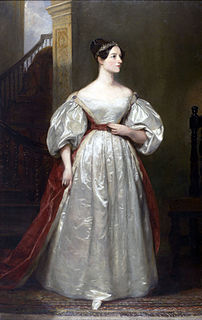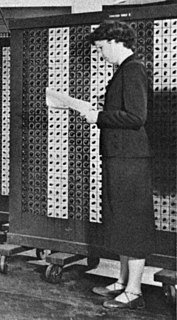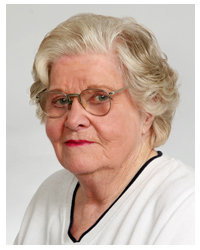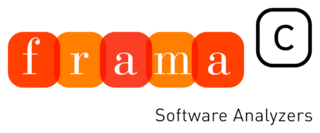Related Research Articles
Computer programming is the process of designing and building an executable computer program to accomplish a specific computing result or to perform a specific task. Programming involves tasks such as: analysis, generating algorithms, profiling algorithms' accuracy and resource consumption, and the implementation of algorithms in a chosen programming language. The source code of a program is written in one or more languages that are intelligible to programmers, rather than machine code, which is directly executed by the central processing unit. The purpose of programming is to find a sequence of instructions that will automate the performance of a task on a computer, often for solving a given problem. Proficient programming thus often requires expertise in several different subjects, including knowledge of the application domain, specialized algorithms, and formal logic.
In computing, a compiler is a computer program that translates computer code written in one programming language into another language. The name "compiler" is primarily used for programs that translate source code from a high-level programming language to a lower level language to create an executable program.

A computer program is a collection of instructions that can be executed by a computer to perform a specific task.

COBOL is a compiled English-like computer programming language designed for business use. It is imperative, procedural and, since 2002, object-oriented. COBOL is primarily used in business, finance, and administrative systems for companies and governments. COBOL is still widely used in applications deployed on mainframe computers, such as large-scale batch and transaction processing jobs. However, due to its declining popularity and the retirement of experienced COBOL programmers, programs are being migrated to new platforms, rewritten in modern languages or replaced with software packages. Most programming in COBOL is now purely to maintain existing applications; however, many large financial institutions were still developing new systems in COBOL in 2006 due to the mainframe processing speed.

Grace Brewster Murray Hopper was an American computer scientist and United States Navy rear admiral. One of the first programmers of the Harvard Mark I computer, she was a pioneer of computer programming who invented one of the first linkers. Hopper was the first to devise the theory of machine-independent programming languages, and the FLOW-MATIC programming language she created using this theory was later extended to create COBOL, an early high-level programming language still in use today.

A programming language is a formal language comprising a set of instructions that produce various kinds of output. Programming languages are used in computer programming to implement algorithms.
A software bug is an error, flaw or fault in a computer program or system that causes it to produce an incorrect or unexpected result, or to behave in unintended ways. The process of finding and fixing bugs is termed "debugging" and often uses formal techniques or tools to pinpoint bugs, and since the 1950s, some computer systems have been designed to also deter, detect or auto-correct various computer bugs during operations.
The A-0 system, written by Grace Murray Hopper in 1951 and 1952 for the UNIVAC I, was an early compiler related tool developed for electronic computers. The A-0 functioned more as a loader or linker than the modern notion of a compiler. A program was specified as a sequence of subroutines and arguments. The subroutines were identified by a numeric code and the arguments to the subroutines were written directly after each subroutine code. The A-0 system converted the specification into machine code that could be fed into the computer a second time to execute the said program.
In computer engineering, a hardware description language (HDL) is a specialized computer language used to describe the structure and behavior of electronic circuits, and most commonly, digital logic circuits.
FLOW-MATIC, originally known as B-0, was the first English-like data processing language. It was developed for the UNIVAC I at Remington Rand under Grace Hopper from 1955 to 1959, and helped shape the development of COBOL.
The history of programming languages spans from documentation of early mechanical computers to modern tools for software development. Early programming languages were highly specialized, relying on mathematical notation and similarly obscure syntax. Throughout the 20th century, research in compiler theory led to the creation of high-level programming languages, which use a more accessible syntax to communicate instructions.
In computer science, the term automatic programming identifies a type of computer programming in which some mechanism generates a computer program to allow human programmers to write the code at a higher abstraction level.
Autocoder is any of a group of assemblers for a number of IBM computers of the 1950s and 1960s. The first Autocoders appear to have been the earliest assemblers to provide a macro facility.

Women in computing were among the first programmers in the early 20th century, and contributed substantially to the industry. As technology and practices altered, the role of women as programmers has changed, and the recorded history of the field has downplayed their achievements.
Jean E. Sammet was an American computer scientist who developed the FORMAC programming language in 1962. She was also one of the developers of the influential COBOL programming language.

Frances Elizabeth Holberton was one of the six original programmers of the first general-purpose electronic digital computer, ENIAC. The other five ENIAC programmers were Jean Bartik, Ruth Teitelbaum, Kathleen Antonelli, Marlyn Meltzer, and Frances Spence.

Jean Jennings Bartik was one of the original programmers for the ENIAC computer.

Frama-C stands for Framework for Modular Analysis of C programs. Frama-C is a set of interoperable program analyzers for C programs. Frama-C has been developed by the French Commissariat à l'Énergie Atomique et aux Énergies Alternatives (CEA-List) and Inria. It has also received funding from the Core Infrastructure Initiative. Frama-C, as a static analyzer, inspects programs without executing them. Despite its name, the software is not related to the French project Framasoft.
In computer programming and software development, debugging is the process of finding and resolving bugs within computer programs, software, or systems.
Software is a set of programmed instructions stored in the memory of stored-program digital computers for execution by the processor. Software is a recent development in human history, and it is fundamental to the Information Age.
References
- Holberton, F.E. "Application of Automatic Coding to Logical Processes". Symposium Automatic Programming for DigitalComputers, Office of Naval Research, Dept. of the Navy, Oct. 1954, pp.34-39.
- Hopper, Grace. "Automatic Coding for Digital Computers". High Speed Computer Conference (Louisiana State University) February 1995. Remington Rand.